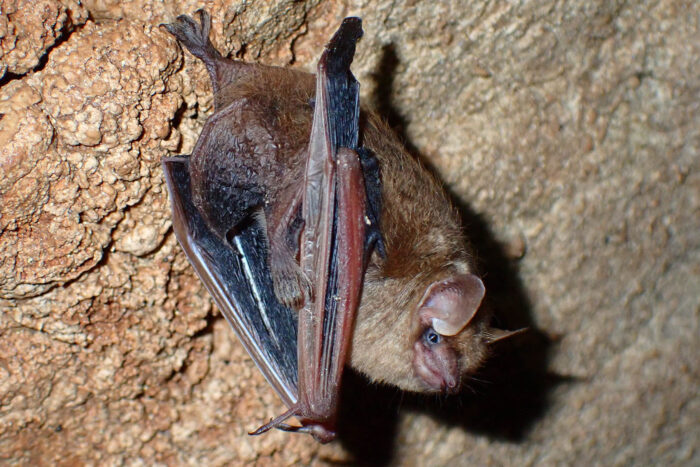Tricolored Bat
Perimyotis subflavus
Weighing only six grams, the tricolored bat is one of the smallest bats in North America.
This section shows one large critter image at a time. Use the thumbnails that follow to select a specific image to display here.

This gallery contains a grid of small thumbnails. Selecting a thumbnail will change the main image in the preceding section.
Appearance
The tricolored is a very tiny bat with fur that appears dark at the base, lighter in the middle and dark at the tip. The bat can often appear yellowish and slightly orange, but they may also appear silvery-gray, brown or black, depending on the season, age and sex of the bat. Newly flying young are much darker and more gray than adults.
Feeding
Tricolored bats typically forage at the top of trees but may forage closer to ground later in the evening. They forage most commonly over waterways and forest edges.
Predators
Snakes, hawks, owls, and other birds of prey will eat tricolored bats. The disease white-nose syndrome has led to the greatest number of tricolored bat fatalities. In colonies where the disease spreads, 90-100% of the bats eventually die.
Flight
When foraging, tricolored bats exhibit slow, erratic, fluttery flight.
Reproduction and life cycle
From mid-August to mid-October, tricolored bats swarm outside caves and mines to mate. Afterward, they hibernate in the caves and mines for the winter. Females store male sperm in their uterus during this time, and then fertilization occurs once they emerge in the spring. In the summer, tricolored bats migrate to warmer areas and the females form maternity colonies. Females will give birth between May and July, typically to two young. The young will begin flying at three weeks and starting foraging for themselves at four weeks. The bats disperse once young are capable of flying and will return to their winter habitat in the month to get ready for mating.
Did you know?
Tricolored bats are one of the most prolific natural control measures of grain moths and beetles.
In general, bats contribute at least $3 billion annually to the U.S. agriculture economy through pest control and pollination
The U.S. Fish and Wildlife Service has proposed that the tricolored bat be added to the endangered species list due to population loss from white nose syndrome.
The tricolored bat is one of the smallest bats native to North America, and the smallest in Maryland.
The bat is formerly known as the eastern pipistrelle.
Sources and additional information
Tricolored bats - U.S. Fish & Wildlife Service
Tricolored bats - Maryland Department of Natural Resources
Service proposes to list the tricolored bat as endangered under the Endangered Species Act - U.S. Fish & Wildlife Service
